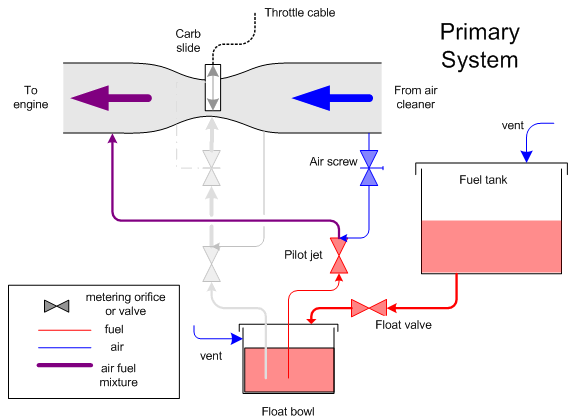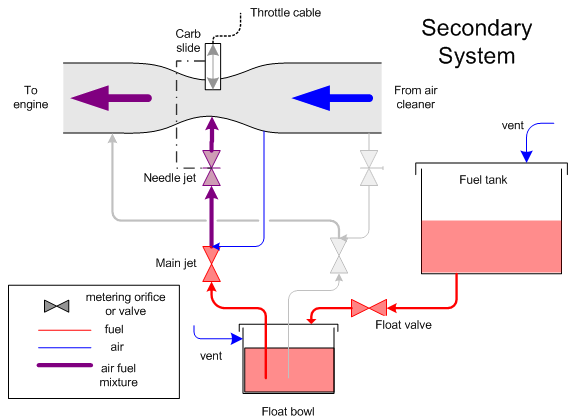Over the next few months, we'll attempt to tackle another topic of considerable intrigue- carburetion. In this day and age of fuel injected cars and even scooters, the off-road motorcycle is one of the last bastions of the venerable carburetor - simple (actually), easy to tune, and pretty reliable. But its operation is a mystery to most, and because of that carburetor troubleshooting and tuning has earned a reputation akin to black magic, when in reality a fundamental understanding coupled with a little experience in interpreting engine feedback is enough to become fluent in the ways of old fashioned air-fuel mixing. For the next three issues Kids' Korner will delve into the operating principles of the carburetor, then deal with how to make adjustments (jetting, etc), and lastly review the aftermarket carb options available to the mini-quad enthusiast.
Basic Function Fundamentally, and entirely, the carburetor's job is two-fold: first - to throttle (or control) the airflow to the engine, and second - to add fuel in the appropriate quantity to that airflow. That's it. Period. But notice the subtleties of that definition. First we need airflow, then we need fuel. Put another way, your right hand is not connected to the "gas", but more accurately to the "air". The ability to produce power is directly linked to engine's ability to injest air. Porting, low restriction intake, and tuned exhaust all are designed to improve airflow into the engine. Of course, air has no energy content, gasoline does. But because the two are mixed together in a precise ratio, more air translates to more fuel, and more fuel (which does have energy content) translates to more power. However, somehow, power needs to be controlled from zero to maximum. That's where the first function of the carb comes in - the throttle limits the airflow, and therefore the power. Nothing particularly magical about the throttle. Suffice it to say that the throttle accomplishes two things - it limits airflow, and creates vacuum between it and the engine. So let's talk about fuel now. There is a chemically correct ratio of air to fuel, which is called the stoichiometric ratio. For gasoline, this ratio is about 14.5 lbs of air to 1 lb of fuel. Your fuel injected car runs that ratio nearly exactly all the time thanks to things like computer control, and oxygen sensors. Its catalyst needs that type of control to keep the exhaust clean. But for off-road, performance-oriented engines, a little richer is better, like around 12-13:1. But how exactly do we accomplish that with an antiquated hunk of die-cast aluminum? With some pretty basic fluid mechanics...
The "Primary" System
Let's pretend we're inventing the carburetor, and
start out with a pretty simple scenario: your engine is idling,
therefore not much air and fuel is required. That means the
throttle is almost complete closed, and there is a high amount of
vacuum between the engine and carb. If we want to match the
airstream with some fuel we could tap into the float bowl and
direct that fuel into the vacuum side of the throttle. The vacuum
created by the engine with the throttle closed will draw the fuel
up from the bowl. We would drill this passage pretty big, but then
limit the fuel by installing a smaller orifice inline. We'd keep
changing this orifice until just the right amount of fuel was
passing into the carb. To fine tune that fuel flow, we could add a
needle valve that's adjustable by hand. In a nutshell, this is
your primary fuel circuit.
In our
simplistic schematic below the inline orifice is more commonly
identified as the pilot jet. The hand adjustment is the low-speed
mixture screw, or idle mixture screw, or air screw. From the
diagram below you'll notice that there's a path from the
air-cleaner side of the carb to the near the pilot jet. This
illustration shows an alternate way to control fuel flow through
the primary circuit, which is by displacing the fuel by air fed in
through the air screw. The more we open the air screw screw the
leaner the mixture will be.

The "Secondary" System
But sitting around idling will get old pretty
quick. We need to make some power to get the machine moving. So we
start to crack open the throttle, which has a dual effect. First it
increases the airflow to the engine, and second it drops the
vacuum. As far as the primary circuit is concerned, this is
problematic for a couple reasons. The drop in vacuum means there's
less "force" pulling the fuel into the intake stream. To compound
this, there's a lot more air going into the engine without an
accordingly higher amount amount of fuel. We need a new method to
draw fuel from the float bowl...
Here's
where a bit a fluid dynamics comes into play, thanks to a guy named
Bernoulli who a century ago realized that if you neck a tube down
in the center (like an hour-glass laying down) then a vacuum will
be produced at the center that's proportional to the airflow, aka a
venturi. Sweet, just what the doctor ordered. That'll be
perfect when the throttle is wide open. If we add an orifice (a
main jet!) between the float bowl and the venturi port we
can vary the amount of fuel that's delivered. Theoretically, this
shouldn't change much, but adjustments might be necessary to
compensate for air density variations (due to humidity,
temperature, barometer), and for things that might affect the
vacuum signal between the venturi and bowl (like air-cleaner
restriction).

The "Everything Else"System Alright, it looks like we got both ends of the operational spectrum covered. But not too many of us work the throttle like a light switch. We need a system to handle the varying fuel delivery requirements at part throttle. Problem is, at part throttle the venturi is really sucking (literally), and although the main jet is sized perfect for wide open throttle, it's just too big and supplying too much fuel at part throttle. We're running way too rich. A system for trimming the fuel flow according to throttle position is what's really required. Since the throttle slide is moving up and down why not attach a long tapered needle to the slide and move it in and out of another orifice, so that the cross-sectional area available for fuel flow changes as the needle moves up and down? Perfect. At idle (throttle closed and needle down) it pretty much blocks any fuel flow. And at full throttle the needle is completely out of the way, thus allowing the main to perform full fuel metering duty. Now why didn't we think of that!? >>> Next Month- "Tuning and Troubleshooting" We'll deal with the specific tuning and diagnotic issues unique to the Mikuni carbs found on the Asian mini-quads such as jetting, spark plug reading, and mixture adjustment. Stay tuned for more!


 Your Privacy Choices
Your Privacy Choices